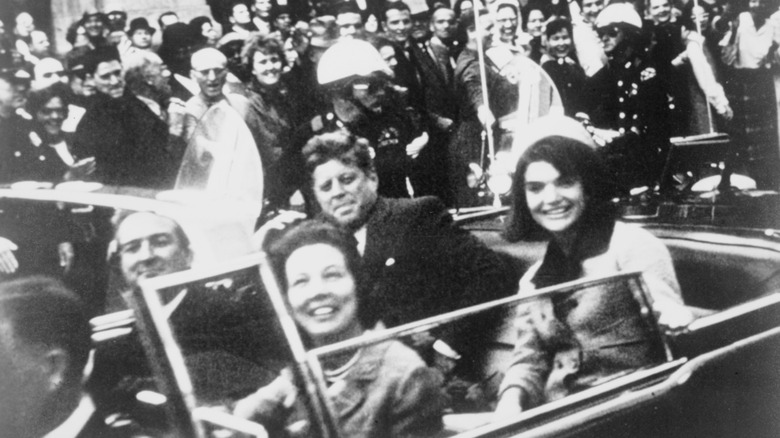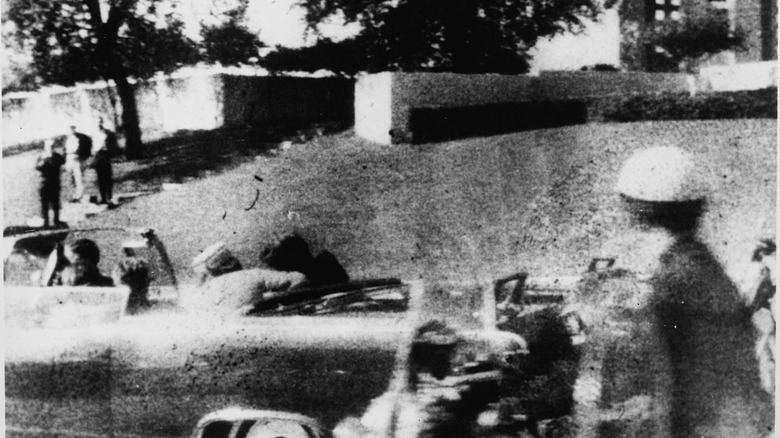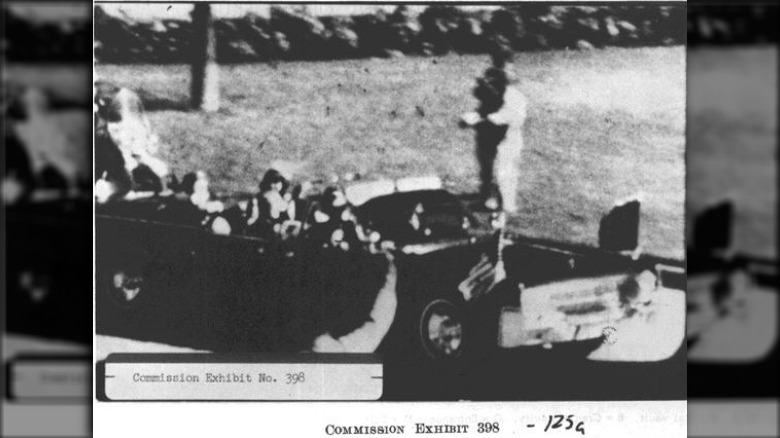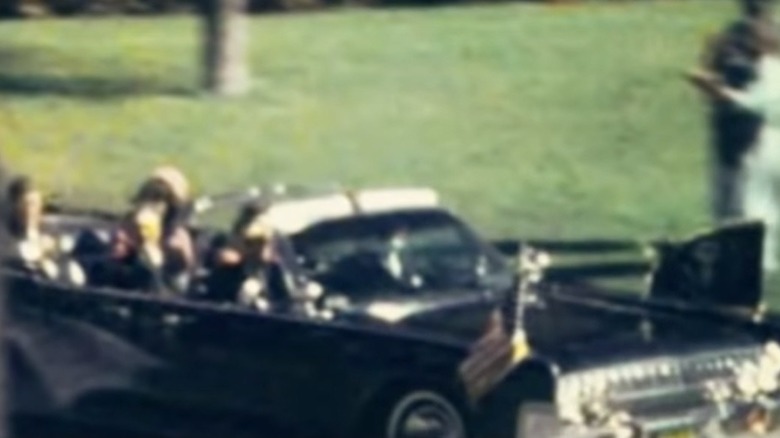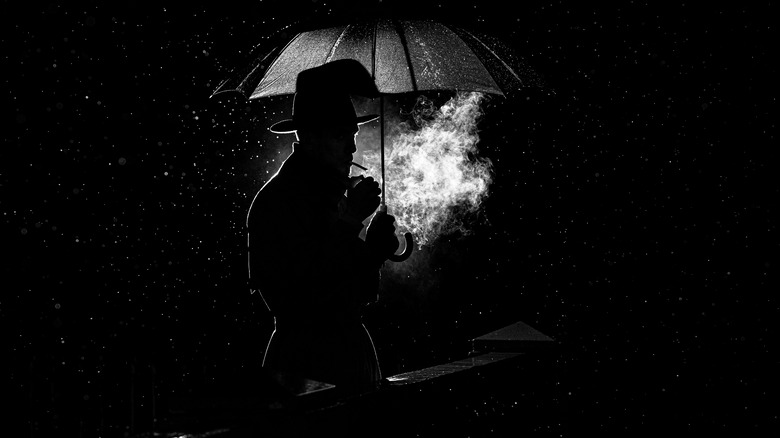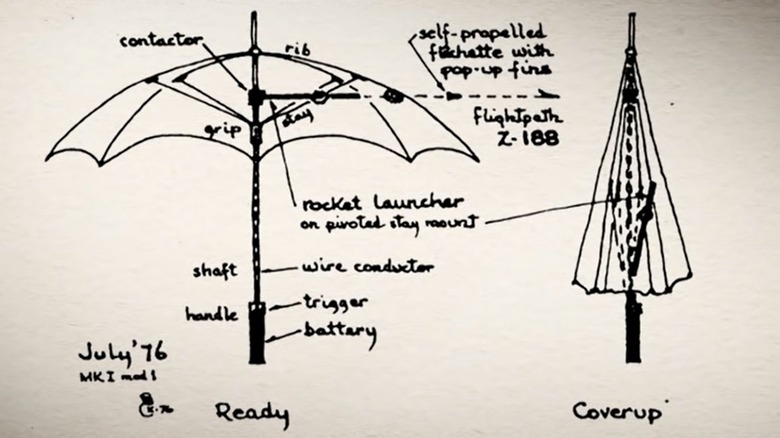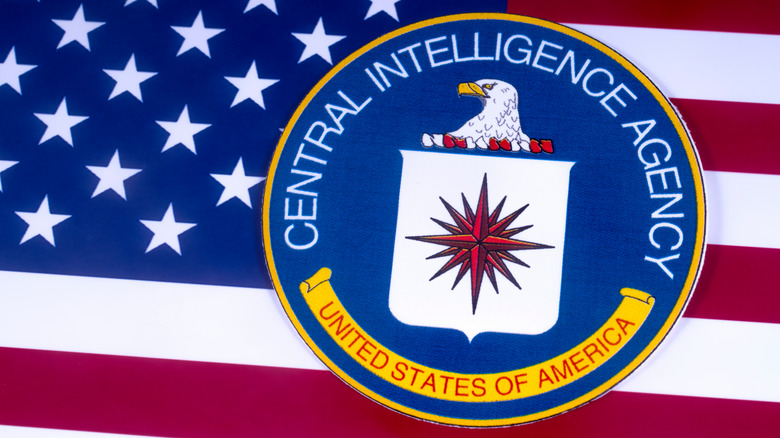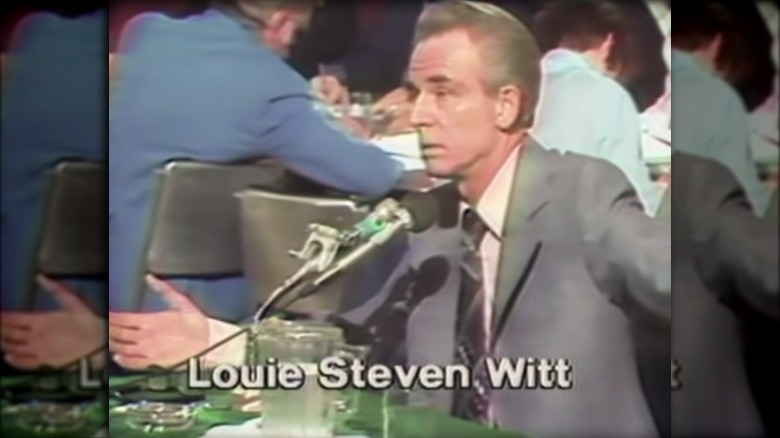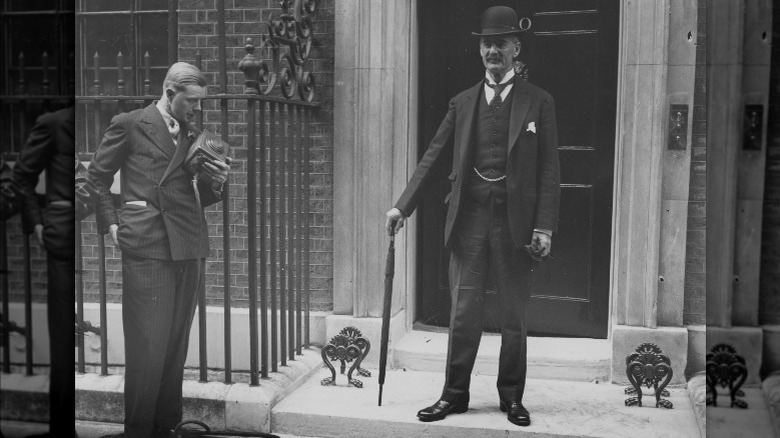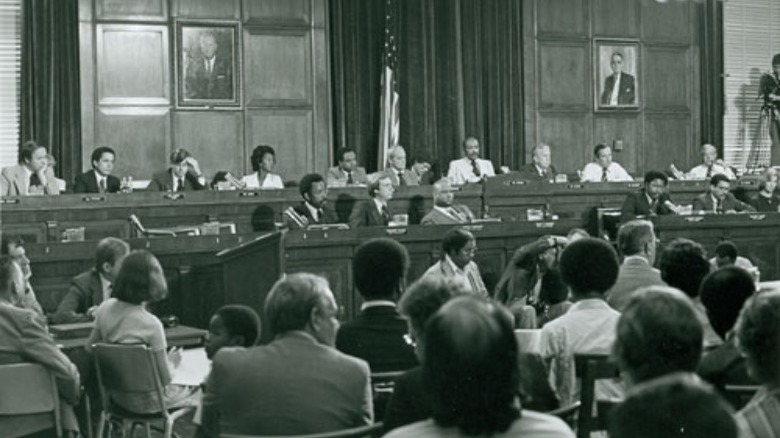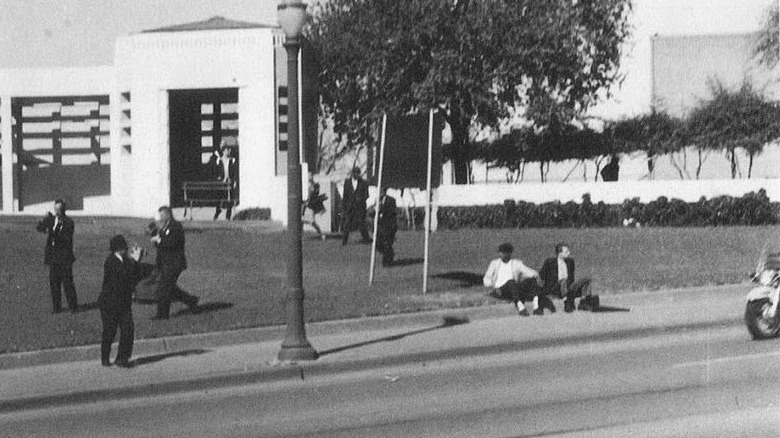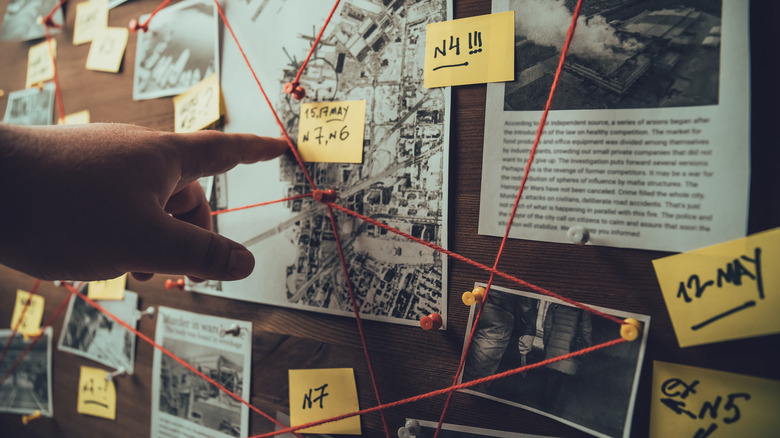The Mystery Of The Umbrella Man At JFK's Assassination
The assassination of President John F. Kennedy — a tragic and dramatic moment in American history, without a doubt. According to the official explanation, it's all pretty straightforward. It was November 1963, and Kennedy was campaigning for the next presidential election in the coming year. He knew he had to win in Texas and flew out to Dallas, riding in a parade on November 22, on the way to give a speech. But he wouldn't make it. At 12:30, near Dealey Plaza, gunshots rang out, hitting him in the neck and head. Kennedy was pronounced dead just a half hour later, and it didn't take long for police to arrest Lee Harvey Oswald for the assassination. Oswald himself was killed just a couple days later, shot at point blank range.
While that's the official story, not everyone actually accepts it as fact. Plenty of people don't, and questions have floated around the assassination for decades. What if Oswald wasn't working alone? Was there a cover up? Who's the random guy with the umbrella?
Believe it or not, the last question has spawned some really wild theories, and, in a way, still does. People have cooked up some crazy and creative ideas about this mysterious Umbrella Man — the kinds of ideas that make for the best conspiracy theories.
The JFK assassination is rife with conspiracies
If you're looking for conspiracy theories, the JFK assassination really is the right place to go. There's no shortage of them. (According to Smithsonian Magazine, more than half of the American public believes in some kind of Kennedy assassination conspiracy theory). These conspiracies are pretty wild. University Press of Kansas' summary of Josiah Thompson's "Last Second in Dallas" mentions the theory that Oswald didn't act alone. There was another shooter — a second lethal shot that came from the other direction. Then there's a recording that seems to capture the sound of a fourth shot, which would also imply a second shooter from the so-called "grassy knoll." Or there's the gun that Oswald was using; it should've been way too hard for him, alone, to have made those three shots as quickly as he did. So clearly, there was another assassin!
But then, why wasn't that other person caught? Or maybe, Oswald and any potential accomplices were working with someone powerful — the American military, Lyndon B. Johnson, or maybe even the mob (via CNN). They all could've had their reasons for wanting Kennedy dead, right?
Really, though, a lot of these theories have been debunked, but they really go to show the sort of ideas that float around the JFK assassination. So, really, the fact that there's a mystery surrounding a figure known as "the Umbrella Man" probably doesn't come across as all that surprising.
There are some weird factors in the JFK assassination that are hard to explain
When it comes to the JFK assassination, there's this piece of evidence that comes up often: the Zapruder Film, 26 seconds of film capturing the moment of Kennedy's assassination. When it comes to the American public, Smithsonian Magazine paints the footage as devastating to the country at large. But it's also the lifeblood of conspiracy theorists who pour over those 486 frames of footage (one of which is shown above), looking for anything out of the ordinary. In a way, it's a little hard to blame them, because that incessant searching has dug up some weird details.
A 1978 article, "The Umbrella System: Prelude to an Assassination," examined those specific frames that included the shooting, lining up Kennedy's movements with the shots, but it's weird. At one point, his hand moves forward, despite a bullet hitting him that should have thrown him backwards. Then, as the other bullets hit him, his fists are clenched tight and never loosening, his body just generally stiff — he didn't even cry out in pain (supposedly — this point is contested). In contrast, Governor John Connelly was also hit in the attack, but recoiled and fell to the floor — much more movement than was seen from Kennedy, but what's with the difference?
Oh, and there was a small hole found in his neck. Maybe an exit wound, but also, maybe not.
What made the Umbrella Man so suspicious?
The more people started to take a look at the Zapruder Film, the more one strange little detail stood out.
To paint a picture, it was November 22, 1963 in Dallas, Texas. It had rained earlier that morning, according to "The Umbrella System: Prelude to an Assassination," but by the time the president's motorcade was to pass through the city, the skies had cleared. It was, by all means, a beautiful day in the neighborhood — a mild 68 degrees and sunny.
But, keeping that in mind, it really makes one man in the Zapruder Film stand out. As Josiah Thompson explains in a short film by Errol Morris, there's a person holding an open black umbrella (seen in the bottom left of the image), right in the same place where the shots are fired. This one young man is the only person in the entire crowd with an umbrella over their head, but why? It's a sunny, pleasant day — one that shouldn't call for an umbrella. But he's standing there, just tens of feet where the President has been shot. It's definitely really weird, and that just makes it so easy to assume that there's something sinister behind the mystery.
The umbrella might have been a signal
Alright, so we know that the Umbrella Man was there at Kennedy's assassination, mere feet away from where everything went down, but was he involved? And how? One early theory, put together by Josiah Thompson and Richard Sprague (and mentioned in "The Umbrella System: Prelude to an Assassination") says that, yes, the Umbrella Man was, in fact, involved. But, no, he wasn't there pulling another weapon on the president. At least, not in this theory.
Basically, he was just an accomplice, and the umbrella was meant as a way for him to communicate with the actual shooter (or shooters, if you ascribe to that particular theory). It would be used to signal timings, like when the two volleys of shots were meant to go off. Opening the umbrella was the signal to shoot the first time. Raising it higher was the signal for the second round of shots.
In all fairness, it's an interesting theory, but Sprague and Cutler actually debunk it themselves. While it's true that the Umbrella Man was raising his umbrella around that point, he was raising it and lowering it pretty quickly. Which was actually way too quickly for it to function as any sort of helpful signal, especially to anyone as far as the shooters would have to be. So maybe this theory doesn't hold all that much water.
Or the umbrella might have been a gun
Alright, so here's a really weird one that's also incredibly straightforward: the umbrella was a gun. In "The Umbrella System: Prelude to an Assassination," it's pointed out that as Kennedy's car passes by, you'd think that the Umbrella Man would turn his head to watch, right? But he doesn't. Instead, he rotates his umbrella, almost like he's tracking Kennedy's movement with it.
But how does that relate to a gun? Well, it relates because this ridiculous umbrella gun technology was actually in development at the time. Documentation is out there for poison dart shooters that could be fitted into things like canes, pens, and — you guessed it — umbrellas. Schematics for this thing actually were drawn up to prove a point. Essentially, the dart launcher worked on an electronic trigger, and when the umbrella was open, it could shoot a dart — usually called a flechette, in this case — horizontally. But when the umbrella was closed, that tube shaped launcher would fold up with the ribs of the umbrella.
All that said, the full theory goes like this: the Umbrella Man opened his umbrella to shoot Kennedy with a poison-tipped flechette (hence why he seemed to be tracking him). The dart hit Kennedy in the neck (creating the small hole that's officially called an exit wound, but is often speculated about) and quickly paralyzed him. That left him stiff, and a sitting duck for the lethal gunshots.
The Umbrella Man might've had friends in high places
So, let's just go with the assumption that the umbrella was actually a gun. Because if you start from that particular conspiracy theory and go a little deeper, the implications get even weirder. After all, think about it: where would this seemingly random man get tech like this? The answer: The Army. Or maybe the CIA.
"The Umbrella System: Prelude to an Assassination" mentions some of the early history of these flechette launchers, with its first introduction to the US government taking place in front of Colonel L. Fletcher Prouty in his office in the Pentagon. Of course, people were interested, and further development on it started in earnest, but all of that development was conducted as top secret research, which involved people from the Special Forces and the CIA. And that was all in 1960; by the time of Kennedy's assassination a few years later, only a small group of people from those two groups knew anything about these weapons. No one else could've gotten their hands on it.
But the Umbrella Man supposedly did.
And if the confidential nature of the weapon wasn't weird enough, then there's the argument that the Umbrella Man should've been questioned that day. A potential weapon or weapon concealer shouldn't have been allowed that close to the parade path at all, but the Secret Service didn't apparently care, and he was just allowed to leave without questioning.
The Umbrella Man himself eventually came forward
Fifteen years. That's what it took. Fifteen years of speculation, after which the Umbrella Man finally revealed himself as Louie Steven Witt when he officially testified regarding the events of that day. And, well, per his testimony in 1978, the entire story was a lot less interesting than everyone had made themselves believe.
Witt just wasn't really a fan of the Kennedy family. Explaining that he leaned more conservative, he didn't particularly like that there was a liberal president in the White House. So on the day of the parade, he took this big, clunky black umbrella with him to heckle the president. Just a little bit of protest, really. He'd chosen to stand where he did because it was a little less busy in that area, and he was a private person who didn't want to be asked by everyone around him why he was opening an umbrella (rather ironic, in the end). Plus, it would be easier for the president to see his little protest. Then it was just some really unfortunate timing that meant he happened to open the umbrella at the same moment the President was shot. Just the absolute worst case of "wrong place, wrong time."
Oh, and he also brought the umbrella to court with him. It was opened and inspected to prove that it was, in fact, only an umbrella.
The actual meaning behind the Umbrella Man's umbrella
This whole idea of "wave around a black umbrella as a way to heckle the president" probably sounds a little strange. The historical context really does help. To clarify, this black umbrella thing wasn't specific only to JFK; according to the Washington Post, it was meant as a symbol against the entire Kennedy family, and a direct reference to the past Prime Minister of England, Neville Chamberlain, who always carried around a black umbrella. If the name Chamberlain rings a bell, that's completely understandable. He's the guy responsible for the appeasement policy before World War II — basically, giving Hitler parts of Europe and hoping that'd placate him. Obviously, that didn't work, and so Chamberlain, in a way, is kind of responsible for letting World War II happen. Not a great mark on history.
The Kennedy family got lumped into this because John F. Kennedy's father, Joseph Kennedy, was a supporter of Chamberlain. Given the infamy of the appeasement policy, it wasn't a good association to have. So people who disliked the family showed it by waving around these black umbrellas at them; it actually happened once with a whole crowd at an airport.
The funny thing, though? Louie Witt himself didn't even fully know this context. In his testimony, he said he only knew about it in a general sense, that it had something to do with Joseph Kennedy and was a "sore spot" for the family.
So why didn't the Umbrella Man say anything for so long?
Obviously, it was really helpful that Louie Witt eventually came forward with his story, but that didn't happen until 1978, a full 15 years after the assassination. What's with that? Did he have something to hide?
Again, no. The truth was so much simpler.
According to Witt in his testimony to the House Select Committee on Assassinations (HSCA), he and his family were just very private people. He wasn't planning to make any waves. But, beyond that, he actually had no idea any of this conspiracy theory stuff was even happening. He legitimately just didn't know that he'd become the center of all this speculation, because, really, why would anyone assume that their little act of silent protest would drop them in the middle of a decade and half long conspiracy? He only found out by chance in 1978 because he happened to see talk of it in the newspapers and recognized himself in the photos. He realized that people were looking for him but didn't go directly to the FBI. He, frankly, didn't want all of these people to know who he was, and didn't want the attention. Plus, he knew word would get out anyway, and someone would eventually come looking for him.
The Umbrella Man might still be connected to another conspiracy
Even with the actual conspiracy around the Umbrella Man seemingly put to rest by Louie Witt's testimony, that doesn't mean he wasn't tangentially related to some other conspiracies. "The Umbrella System: Prelude to an Assassination" makes mention of radio communication going on that day, with Jim Hicks claiming to have provided radios to a firing team, though he didn't do much beyond that. Communication fell to another man, who was presumably found in the Zapruder Film, hand raised and holding a button, radio at his belt. After the shooting, he sat down next to Witt for a couple of minutes.
It was assumed the two were working together, discussing the results at that time. Witt's testimony throws a wrench in that, obviously, but even if he wasn't an accomplice, he was still questioned about that man. As far as Witt could remember, the man had just said something about Kennedy being shot, but he didn't recall anything suspicious. As for whether or not he had a radio, Witt explained that he probably didn't, but he'd also been in shock at the time.
Then there's also the question of another shooter at the "grassy knoll," behind a retaining wall (via Washington Post). Witt was also questioned about that, since he was in the same area, though if anyone was there, they would've been behind him most of the time. He couldn't see much.
The Umbrella Man conspiracy might just be a cautionary tale
At the end of all of this, there's a moral worth taking from the story of the Umbrella Man and the conspiracy surrounding him. After all, if you look at the entire journey that this conspiracy took, it's pretty ridiculous. A man shows up with an umbrella to voice a little annoyance with the Kennedy family, ends up the witness to an assassination, and then has conspiracy theorists thinking that he's an accomplice, or connected to the CIA, or in possession of a secret weapon that shoots poisonous, dissolving darts (via Smithsonian Magazine and "The Umbrella System: Prelude to an Assassination").
Josiah Thompson says it best. When you're looking at anything on just the surface, then things are going to look completely normal. But once you start digging around in the details, you'll find something weird. And that's not just with something like a presidential assassination; it's true of anything. Every story has its own weird little details that could spawn conspiracies if someone felt like looking hard enough. And once you find those details, it's so much easier to come up with sinister or malicious explanations (top secret CIA weapons) rather than what might be true (a weird, somewhat outdated political protest).
That said, conspiracy theorists aren't going away any time soon. Even with Witt's testimony, some people still believe that was a lie and a cover-up. The mystery lives on.
